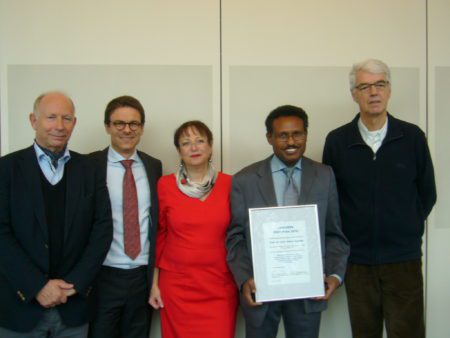
Left to Right: Martin Wettstein, Dr. Michael Montemurro, Helga Meier Schnorf, Prof. Abbas Agaimy, Prof. Richard Herrmann
GIST Group Switzerland, the support group for patients with gastrointestinal stromal tumor (GIST), has awarded its science prize for the seventh time. The 2016 GIST prize, worth CHF 10,000, was awarded to Professor Abbas Agaimy, a pathologist from University Hospital, Erlangen Germany for his various publications on “Gastrointestinal stromal tumor; morphological and molecular genetic characterization with a focus on their preclinical and early clinical precursors.”
The award ceremony took place on November 24, 2016 at the semi-annual meeting of the Swiss Group for Clinical Cancer Research (SAKK), held in Zurich.
The laudation was held by Professor Richard Hermann, Basel, member of the GIST Group Award Committee.
A summary of Professor Agalmy’s research follows:
Gastrointestinal stromal tumor: morphological and molecular genetic characterization with a focus on their preclinical and early clinical precursors:
Gastrointestinal stromal tumors (GIST) represent the most common primary tumors of the connective tissue of the digestive tract. According to their connective tissue origin, the malignant variants are considered “sarcomas“. These neoplasms however differ significantly from sarcomas of the extremities in all aspects including their genetics as well as the clinical and therapeutic characteristics.
Since the introduction of a highly effective medical treatment (imatinib) for these sarcomas which were otherwise well known to be chemo- and radiation-resistant, there has been a need for urgent establishment of reliable diagnostic criteria as well as predictors to select patients who are at higher risk for disease relapse and who need specific therapy and to predict the expected therapy effect on an individualized basis.
Our research studies (done together with several national, European and international cooperation partners) used these objective as their main focus. We were the first group to highlight a very high frequency of small (pre-clinical) GIST tumors (which we called Tumorlets) in middle-aged adults. Although these minute tumors essentially do not have a prognostic value, they are frequently detected during surgery for other gastrointestinal diseases or even during resection of large GIST mimicking metastases and can thus lead erroneously to overtreatment. Also their multifocal occurrence may mimic hereditary diseases caused by germline genetic changes. Our works illustrated this feature and, using a helpful diagnostic algorithm, defined how to correctly recognize these lesions as independent to distinguish them from metastases and from genetic syndromes associated with multiple GIST.
In addition, we highlighted some epidemiological aspects related to the frequency and types of second malignancies developing at same time, before or after diagnosis of a GIST thereby addressing in particular their prognostic and therapeutic consequences. The potential value of macroscopic growth pattern as a possible explanation for different recurrence rates among tumors with similar sizes and mitotic index represented another novel aspect we have addressed in an independent study.
Our intensive studies on the genetic changes in GIST from different organs of the digestive system correlated with their morphological features under the microscope enabled us to establish what we refer to as the “Erlanger Approach“ for mutation testing. Thus, taking into account the tumor site, morphology, and if necessary, some additional special stains, we identify which gene (KIT or PDGFRA) and which region (exon) of that gene should be analyzed first with a very high probability rate (>95%). In this way, we are able to significantly reduce the costs, the work load of the molecular lab and the time needed to finalize the results and hence to facilitate the beginning of immediate therapy.




